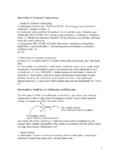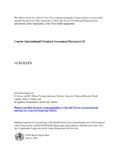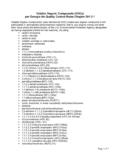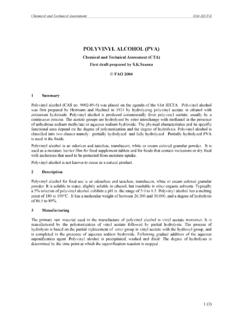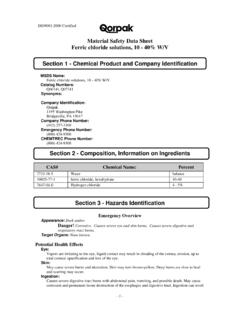Transcription of Exercise:) UVspectrum)of)acrolein)
1 exercise : UV spectrum of acrolein acrolein = 2- propenal (H2C=CH- HC=O) 1. Construct the molecule using Molden a. Use the molecular editor b. Save in Gaussian cartesian format source /home/ippoliti/PROGRAMS/ molden 2. Optimize the molecular structure (keyword opt) with Gaussian using the methods (keywords, used in addition to other keywords) a. HF/cc-pVDZ b. B3 LYP/cc-pVDZ c. Check the optimization convergence with Molden or directly in the output file d. Verify that the optimization reached a minimum on the potential energy surface by performing a vibrational analysis at the optimized geometry.
2 All calculated frequencies must be positive (a single negative (imaginary) frequency defines a transition state; more than one negative frequency represent higher- order saddle points usually without physical meaning) Either save the optimized (= final) geometry with Molden or copy it directly from the output file (search for last entry Standard orientation) Keywords for vibrational analysis: freq=raman Gaussian input file format: # HF/cc-pVDZ opt acrolein Ground state optimization 0 1 C C C O 0. H 0.
3 H H H 0. (ends with blank line) source /home/ippoliti/PROGRAMS/ g09 & tail -20f (shows the updated last 20 lines of the file) Geometry optimization: Look for convergence criteria in the output file: Item Value Threshold Converged? Maximum Force YES RMS Force YES Maximum Displacement YES RMS Displacement YES Predicted change in Energy= Optimization completed. -- Stationary point found. Vibrational analysis: Search for Harmonic frequencies (you can also visualize the normal modes in Jmol or Molden, see also additional exercise 7) 3.
4 Calculate the molecular orbitals (MOs) at the optimized geometries a. Keywords (instead of opt): pop=full gfprint 4. Analysis of MOs a. Visualize the MOs with Jmol (either Applet on the course website or stand- alone version on the grs cluster: jmol) i. Load up your Gaussian output file ii. If you use the stand- alone version: open a console window of Jmol (right mouse button opens an extended menu) and type: frame 2 iii. Then you can visualize the MOs (Surfaces, Molecular orbitals) b. Sketch a qualitative MO diagram (energy levels + MOs for the 4 highest occupied and the 5 lowest unoccupied (virtual) MOs) c.
5 Characterize the MOs ( , , n, bonding, antibonding) 5. Calculate the UV (vertical excitation) spectrum (at the respective optimized geometries) using configuration interaction with single excitations (CIS) as well as time- dependent DFT (TDDFT): Keywords (complete): a. CIS(nstates=6)/cc-pVDZ b. B3 LYP/cc-pVDZ TD(nstates=6) 6. Analysis of UV spectrum a. Characterize the excitations ( *, ..) for the first few excited states b. Compare the results of CIS (based on HF) and TDDFT calculations c. Compare to the experimental UV spectrum Look for the following entry in the output file: Excitation energies and oscillator strengths: Excited State 1: Singlet-A eV nm f= <S**2>= 14 -> 16 14 -> 20 This state for optimization and/or second-order correction.
6 Copying the excited state density for this state as the 1-particle RhoCI density.. The notation 14 -> 16 refers to an excitation from MO 14 to MO 16. The coefficient (here ) is the contribution of the respective excitation to the CI wave function. To get a percentage the coefficient needs to be squared and multiplied by 2 (c c 2) to account for 2 contributions in a properly spin- adapted eigenfunction. f is he oscillator strength which can be compared to the integrated intensity of an experimental absorption band. 7. Additional exercise : Vibrational analysis using the DFT results a. Visualize the vibrational normal modes in Jmol (or Molden) b.
7 Assign the character of the normal modes ( stretching, deformation: in- plane bending, out- of- plane bending, ..) c. Look for IR intensity and Raman activity in the output file. d. Try to assign the vibrational bands in the experimental IR spectrum

